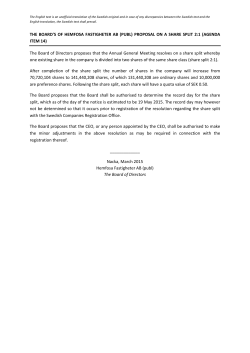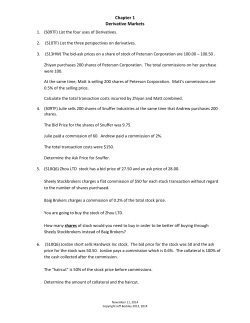
EFFICIENT TRANSMISSION OF SECRET IMAGE BY
International Conference on Computer Science, Electronics & Electrical Engineering-2015 EFFICIENT TRANSMISSION OF SECRET IMAGE BY DIVERSE IMAGE MEDIA USING DIGITAL IMAGE SHARING Sreenivasa T V, IV semM.Tech(DE &CS), Dept.of ECE, Malnad college of engineering,Hassan,Karnataka,India E-mail:sreenivastv.sit@gmail.com M.N.RAVIKUMAR AssociateProfessor,Dept.of ECE, Malnadcollege of Engineering, Hassan ,Karnataka,India E-mail: mnr@mcehassan.ac.in ABSTRACT The technique that used to encrypts a secret image into n shares is called Visual Cryptography (VC), with each participant holding one or more shares. Cannot reveal any information about the secret image that holds fewer than n shares. Stacking the n shares reveals the secret image and it can be recognized directly by the human visual systemThe Natural-image-based VSS scheme (NVSS scheme) that shares secret images via various carrier media to protect the secret and the participants during the transmission phase. This scheme can share one digital secret image over many arbitrary selected natural image and one noise-like share. The natural shares can be photos or hand-painted pictures in digital form or in printed form. The noise-like share is generated based on these natural shares and the secret image. The unaltered natural shares are diverse and innocuous, thus greatly reducing the transmission risk problem. Keywords: Secret Image,Visual Cryptography,Visual secret sharing,Conventional shares, secure image transmission, transmission risk I. INTRODUCTION Traditional visual secret sharing schemes hide secret images in shares that are either printed on transparencies or are encoded and stored in a digital form. The shares can visible as meaningful images or noiselike pixels; but it will arouse suspicion and rise the size of interception risk during transmission of the shares. Hence, visual secret sharing schemes suffer from a transmission risk problem for the secret image itself and for the users who are all involved in the visual secret sharing. Visual Secret Sharing (VSS) scheme means Sharing and delivering secret images. The main motivation of Visual cryptography is to securely share secret images in non-computer-aided environmentConventional shares, which have many random and meaningless pixels, and also consist security requirement for protecting secret contents, but they suffer from two drawbacks first one is, we have high transmission risk because holding noise-like shares will cause attackers suspicion and the shares may be predictable. Hence, which has high risk to both the users and the shares increases, in turn transmission failure probability increases. Second, the generated shares are may not be a user friendly. As the number of shares doubles or increases it becomes more and more cumbersome to manage that large number of sharesAdopting steganography techniques, secret images can be discovered in cover images that are true-color images and halftone gray images. However, the stego-images still identified by steganalysis techniques. Therefore the existing visual secret sharing schemes still must be investigated for lower the transmission risk problem for shares and carriers. A method for bring down the transmission risk is a main issue in Visual secret schemes. 44 ©2015 ISRASE ISRASE eXplore Digital Library International Conference on Computer Science, Electronics & Electrical Engineering-2015 II. RELATED WORK Recent research into the user-friendly Visual secret sharing scheme provided some effective solutions to cope with the management problem. The shares consists many display low-quality images or noise-like pixels. Such shares are easy to identify by the naked eye, and users who send the share can easily lead to suspicion by others also. By using steganography techniques, secret images can be discovered in cover images that are true-color images and halftone gray image. However, the stego-images still can be identified by steganalysis techniques. Disadvantages of existing system: First, there is a high transmission risk because holding noise-like shares will cause attackers suspicion and the shares may be intercepted. The meaningless or noise-like pixels shares are not user friendly. As the number of shares rise in size or increase, it becomes much more problem to handle the shares, which not at all provide any information for detecting the shares. III. THE PROPOSED SCHEME The proposed Natural-image-based visual secret sharing scheme can share a digital secret image over many arbitrary natural images and one share. Instead of changing the contents of the natural images, the proposed approach take out the features from each natural share. These natural shares which are not altered are not fully harmful. Thus reducing the interception probability of these shares. The produced share that is noiselike can be identified by using data hiding methods or techniques to increase the security level while the transmission phase. The Natural-image-based visual secret sharing scheme uses diverse media as a carrier hence it has so much possible scenarios for sharing secret images. In this paper, we develop more efficient and best encryption/decryption techniques or algorithms for the (n, n) Natural-image-based visual secret sharing scheme. The proposed algorithms are applicable to printed and digital media. The possible ways to hide the generated shares or natural shares are also discussed. Advantages of proposed system: To bring down the transmission risk, the dealer have to choose an image that is not easily suspected as the content of the media (e.g. portrait photographs, flysheets, hand-painted pictures and landscape). The shares can be stored in a participant’s digital devices (e.g., smart phones or digital cameras) to reduce the risk of being suspected. The printed media (e.g., hand-painted pictures or flysheets) can be sent via mail or postal marketing services. In this way, the transmission channels are diverse and further reduces the transmission risk. IV. METHEDOLOGY The proposed method includes two main phases as shown by the flow diagram below: 1) Encryption of secret images into cover image 2) Decryption of Secret images The steps or modules involved in implementation of the project are 1. Select Cover Image 2. Select secret color image and secret BW image 3. Embed the BW image in Color image 4. Embed resultant image of 3rdstep into Cover image 45 ©2015 ISRASE ISRASE eXplore Digital Library International Conference on Computer Science, Electronics & Electrical Engineering-2015 5. Select Encrypted image for Decryption 6. Retrieve Color image from encrypted cover image 7. Retrieve BW image from color image 8. Performance Analysis Fig.1. Encryption Process A. Encryption Process During Encryption of secret images embedding process is done by two times and following steps used from encryption of secret images: Step 1. Select the basic cover image in which secret images are going to embedded and resize the cover image for your convenience Step 2. Select Water mark Color image which is a secret image and do resize to get fitted to cover image Step 3. Select Water mark BW image which also a secret image and do resize to get fitted to color image and which is also convert into column image Step 4. Embed the column image of step 3 into color image and convert the resultant image into column image Step 5. Embed the column image of step 4 into Cover image Now the Cover image contain information of Water mark Color image and Water mark BW image 46 ©2015 ISRASE ISRASE eXplore Digital Library International Conference on Computer Science, Electronics & Electrical Engineering-2015 Fig.2. Decryption Process B. Decryption Process Step 1. Select the Steno image which is an encrypted image resultant of encryption process for decryption Step 2. Extract the Water mark color image from encrypted cover image which is combination of water mark color and water mark BW image Step 3. Extract the Water mark BW image from encrypted Water mark color image which is obtained in step 2 of decryption process Step 4. Do performance analysis III. EXPERIMENTAL RESULTS 1.Encryption Process results Fig a: Cover Image and Water marking color image Fig b: Water marking BW image and 2nd in 3rd encrypted image 47 ©2015 ISRASE ISRASE eXplore Digital Library International Conference on Computer Science, Electronics & Electrical Engineering-2015 Fig c: 1st and 2nd in 3rd encrypted image 2.Decryption Process results Fig d: Decryption input and recovered color image Fig d: Recovered BW image IV.CONCLUSION The paper proposes a VSS scheme that can share a digital image using diverse image media. The media that include many randomly chosen images are unaltered in the encryption phase. Therefore, they are totally innocuous. Regardless of the number of participant’sincreases, the scheme uses only one noise share for sharing the secret image. Compared with existing VSS schemes, the proposed scheme can effectively minimize transmission risk and provide the highest level of user friendliness, both for shares and for participants. This study provides some of major contributions. First, an attempt to share images via heterogeneous carriers in a VSS scheme. Second, this study proposes a useful concept and method for using unaltered images as shares in a VSS scheme. Fourth, we develop a method to store the noise share as the QR code. 48 ©2015 ISRASE ISRASE eXplore Digital Library International Conference on Computer Science, Electronics & Electrical Engineering-2015 REFERENCES [1] M. Naor and A. Shamir, “Visual cryptography,” in Advances in Cryptology, vol. 950. New York, NY, USA: Springer-Verlag, 1995, pp. 1–12. [2] R. Z.Wang, Y. C. Lan, Y. K. Lee, S. Y. Huang, S. J. Shyu, and T. L. Chia, “Incrementing visual cryptography using random grids,” Opt. Commun., vol. 283, no. 21, pp. 4242–4249, Nov. 2010. [3] P. L. Chiu and K. H. Lee, “A simulated annealing algorithm for general threshold visual cryptography schemes,” IEEE Trans. Inf. Forensics Security, vol. 6, no. 3, pp. 992–1001, Sep. 2011. [4] K. H. Lee and P. L. Chiu, “Image size invariant visual cryptography for general access structures subject to display quality constraints,” IEEE Trans. Image Process., vol. 22, no. 10, pp. 3830–3841, Oct. 2013. [5] G. Ateniese, C. Blundo, A. D. Santis, and D. R. Stinson, “Extended capabilities for visual cryptography,” Theoretical Comput. Sci., vol. 250, nos. 1–2, pp. 143–161, Jan. 2001. [6] C. N. Yang and T. S. Chen, “Extended visual secret sharing schemes: Improving the shadow image quality,” Int. J. Pattern Recognit. Artif.Intell. vol. 21, no. 5, pp. 879–898, Aug. 2007. [7] K. H. Lee and P. L. Chiu, “An extended visual cryptography algorithm for general access structures,” IEEE Trans. Inf. Forensics Security, vol. 7, no. 1, pp. 219–229, Feb. 2012. [8] Z. Zhou, G. R. Arce, and G. D. Crescenzo, “Halftone visual cryptography,” IEEE Trans. Image Process., vol. 15, no. 8, pp. 2441–2453, Aug. 2006. [9] Z. Wang, G. R. Arce, and G. D. Crescenzo, “Halftone visual cryptography via error diffusion,” IEEE Trans. Inf. Forensics Security, vol. 4, no. 3, pp. 383–396, Sep. 2009. [10] I. Kang, G. R. Arce, and H. K. Lee, “Color extended visual cryptographyusing error diffusion,” IEEE Trans. Image Process., vol. 20, no. 1, pp. 132–145, Jan. 2011. [11] F. Liu and C. Wu, “Embedded extended visual cryptography schemes,” IEEE Trans. Inf. Forensics Security, vol. 6, no. 2, pp. 307–322, Jun. 2011. [12] T. H. Chen and K. H. Tsao, “User-friendly random-grid-based visual secret sharing,” IEEE Trans. Circuits Syst. Video Technol., vol. 21, no. 11, pp. 1693–1703, Nov. 2011. 49 ©2015 ISRASE ISRASE eXplore Digital Library
© Copyright 2025









